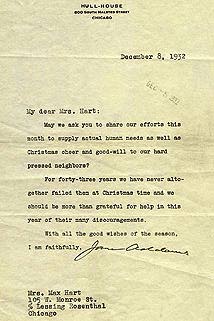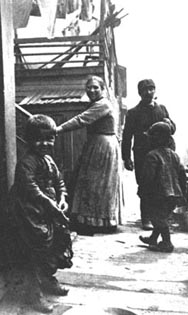 The late 1800's era of incorporation was predated by the advent of statistical use for the "quantitative analysis of society" (Boorstin, 167). A new type of science was born. The founding of the American Statistical Association, the Boston Census of 1845, and the rise of statistical use in setting insurance rates brought this new science into the fabric of top level decision making. Numbers offered credibility. Hull-House residents, responding to professors and politicians who requested numbers and factual support and to the field of sociology that required a scientific approach, included in its first published results, statistics, maps and data to provide a basis for Hull-House theoretical study.
The late 1800's era of incorporation was predated by the advent of statistical use for the "quantitative analysis of society" (Boorstin, 167). A new type of science was born. The founding of the American Statistical Association, the Boston Census of 1845, and the rise of statistical use in setting insurance rates brought this new science into the fabric of top level decision making. Numbers offered credibility. Hull-House residents, responding to professors and politicians who requested numbers and factual support and to the field of sociology that required a scientific approach, included in its first published results, statistics, maps and data to provide a basis for Hull-House theoretical study. 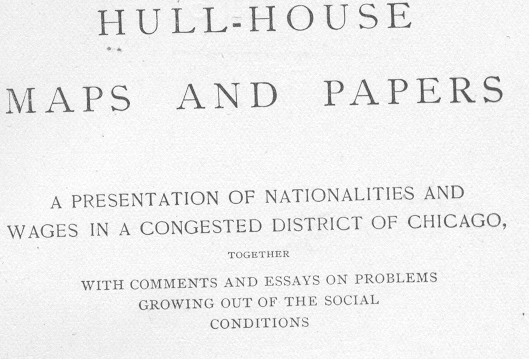 Through its statistical research, Hull-House established its professional expertise and created a platform by which it could redefine poverty. No longer was being poor a moral condition, the fault of the person who must have had some major spiritual lapse, but a social condition with the responsibility partially falling on society to redeem its neighbor. Hull-House sought to "ameliorate the social dysfunction of American modernization" (Jackson,4).
The Hull-House Maps and Papers, an enormously important work, is said to have started the Chicago school of sociology (Stebner,19). After Julia Lathrop began investigating relief applicants in the Hull-House neighborhood, she realized that a full-fledged analysis was needed and she was the inspiration behind Hull-House Maps and Papers.
Through its statistical research, Hull-House established its professional expertise and created a platform by which it could redefine poverty. No longer was being poor a moral condition, the fault of the person who must have had some major spiritual lapse, but a social condition with the responsibility partially falling on society to redeem its neighbor. Hull-House sought to "ameliorate the social dysfunction of American modernization" (Jackson,4).
The Hull-House Maps and Papers, an enormously important work, is said to have started the Chicago school of sociology (Stebner,19). After Julia Lathrop began investigating relief applicants in the Hull-House neighborhood, she realized that a full-fledged analysis was needed and she was the inspiration behind Hull-House Maps and Papers.
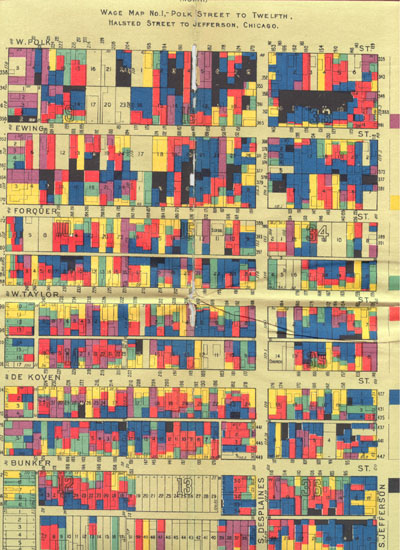 . The volume included color-coded maps (click on map for enlarged view) that divided city blocks according to wage earnings and ethnic composition. Diligent methodology was used as every house or tenement in the neighborhood was visited. The residents offered the maps and papers for "immediate" (Addams, Preface to Maps and Papers) use and value, not realizing that their historic use would be substantial.
. The volume included color-coded maps (click on map for enlarged view) that divided city blocks according to wage earnings and ethnic composition. Diligent methodology was used as every house or tenement in the neighborhood was visited. The residents offered the maps and papers for "immediate" (Addams, Preface to Maps and Papers) use and value, not realizing that their historic use would be substantial.
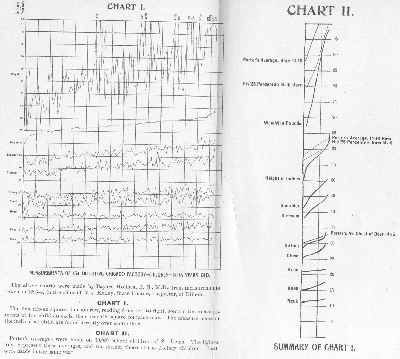 Hull-House also included charts that substantiated the detrimental effects of child labor to persuade passage of child labor laws. The chart on the right was made by Bayard Holmes, M.D. from measurements taken in 1893-1894 in the office of Florence Kelley, Illinois State Factory Inspector and Hull-House resident. The charts compare the relative growth between school children and child factory workers in an attempt to prove the harmful effects of factory work on children.
Hull-House also included charts that substantiated the detrimental effects of child labor to persuade passage of child labor laws. The chart on the right was made by Bayard Holmes, M.D. from measurements taken in 1893-1894 in the office of Florence Kelley, Illinois State Factory Inspector and Hull-House resident. The charts compare the relative growth between school children and child factory workers in an attempt to prove the harmful effects of factory work on children.
